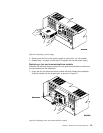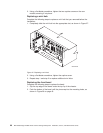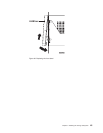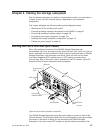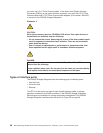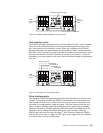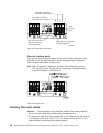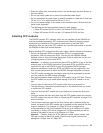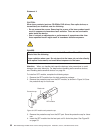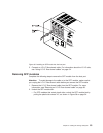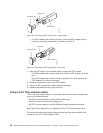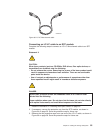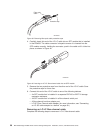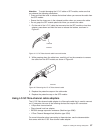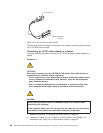v Route the cable away from places where it can be damaged by other devices in
the rack cabinet.
v Do not use plastic cable ties in place of the provided cable straps.
v Do not overtighten the cable straps or bend the cables to a diameter of less than
76 mm (3 in.), or a radius less than 38 mm (1.5 in.).
v Do not put excess weight on the cable at the connection point. Be sure that the
cable is well supported.
v The following are the recommended maximum cable lengths:
– 1 Gbps: 500 meters 50/125 um fiber, 300 meters 62.5/125 um fiber
– 2 Gbps: 300 meters 50/125 um fiber, 150 meters 62.5/125 um fiber
Installing SFP modules
The DS4500 requires SFP modules, which are not supplied with the DS4500 but
must be purchased separately. SFP modules convert electrical signals to optical
signals that are required for fibre channel transmission to and from RAID
controllers. After you install the SFP modules, you use fiber-optic cables to connect
the DS4500 to other fibre channel devices.
Before installing SFP modules and fiber-optic cables, read the following information:
v Do not mix long-wave SFPs and short-wave SFPs on a single storage
subsystem. Use only short-wave SFPs. You can use the DS4000 Storage
Manager client to view the Storage Subsystem Profile to verify that you are not
mixing long-wave and short-wave SFPs.
Attention: In addition, do not use long-wave SFPs or GBICs in any of the fibre
channel ports in the DS4500 controllers. (Long-wave SFPs and GBICs are not
supported for use in the DS4500 or any of the attached DS4000 storage
expansion enclosures. Long-wave SFPs and GBICs are only supported in the
fibre channel switch ports to which the DS4500 Storage Subsystem connects.)
v The SFP module housing has an integral guide key that is designed to prevent
you from inserting the SFP module improperly.
v Use minimal pressure when inserting an SFP module into an SFP port. Forcing
the SFP module into a port could cause damage to the SFP module or to the
port.
v You can insert or remove the SFP module while the port is powered on.
v The operational or redundant loop performance is not affected when you install
or remove an SFP module.
v You must insert the SFP module into a port before you connect the fiber-optic
cable.
v You must remove the fiber-optic cable from the SFP module before you remove
the SFP module from the port. Refer to “Removing SFP modules” on page 53 for
more information.
v The maximum operating speed of the fibre channel port is determined by two
factors: the speed of the SFP module that is installed and the speed of the fibre
channel connection. For example, a 2-Gbps SFP that is plugged into a
4-Gbps-capable port will limit the speed of that port to a maximum of 2 Gbps.
Conversely, a 4-Gbps SFP that is plugged into a 2-Gbps-capable port will be
limited by the speed of the port to a maximum of 2 Gbps.
Attention: Carefully check the SFP's IBM part number, option number, and
FRU part number to identify its speed. There are no physical features that
distinguish a 4 Gbps from a 2 Gbps SFP.
Chapter 3. Cabling the storage subsystem 51



